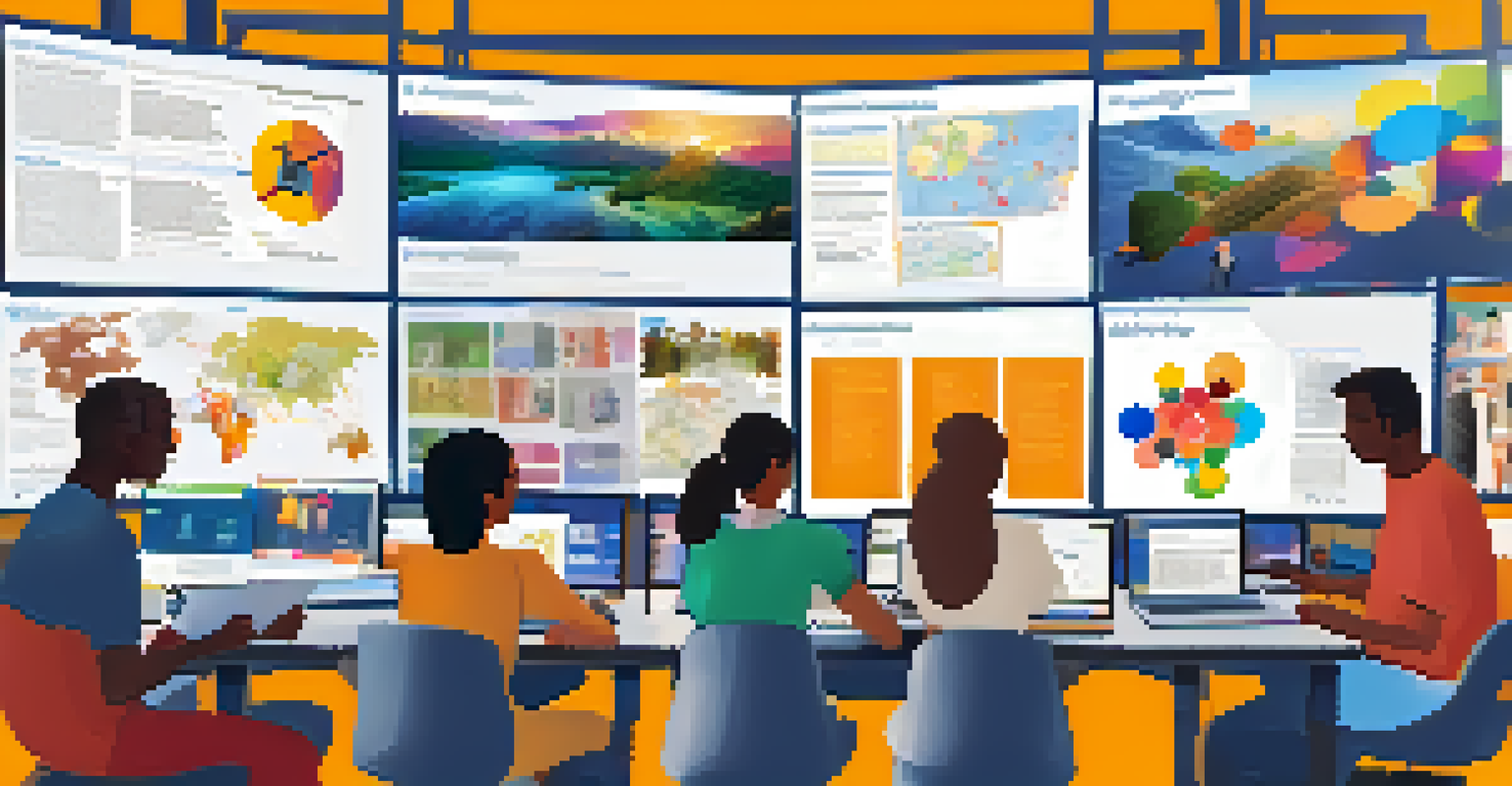Real-Time Learning: Building Community and Collaboration

Understanding Real-Time Learning and Its Importance
Real-time learning refers to the immediate acquisition of knowledge and skills as events unfold, often facilitated by technology. This method allows learners to adapt and respond quickly, making education more relevant and engaging. Imagine a live cooking class where participants can ask questions and receive instant feedback, creating a dynamic learning environment.
Learning is a treasure that will follow its owner everywhere.
The importance of real-time learning lies in its ability to foster a deeper connection between learners and the material. By engaging with content as it happens, participants can relate to real-world scenarios, enhancing retention and application of knowledge. This approach not only benefits individuals but also strengthens the overall learning community.
As we navigate a fast-paced world, the demand for real-time learning continues to grow. Organizations and educational institutions are increasingly adopting this method to ensure that their learners are equipped with up-to-date skills, promoting a culture of continuous improvement.
Building Community Through Real-Time Learning
One of the most significant advantages of real-time learning is its ability to build a sense of community among participants. When learners collaborate in real-time, they share experiences and insights, creating bonds that enhance the learning experience. This communal aspect fosters trust and encourages open dialogue, making everyone feel valued.

Moreover, real-time learning can break down geographical barriers, allowing individuals from diverse backgrounds to come together. For instance, an online workshop can bring participants from around the globe into one virtual space, sharing unique perspectives that enrich discussions. This diversity not only broadens horizons but also cultivates empathy and understanding among members.
Real-Time Learning Enhances Engagement
Real-time learning allows for immediate feedback and interaction, making education more relevant and dynamic.
Ultimately, a strong community nurtured by real-time learning can lead to lifelong connections and collaborations. Participants often find themselves returning to these networks, not just for learning purposes, but also for the friendships and professional relationships formed during these shared experiences.
The Role of Collaboration in Real-Time Learning
Collaboration is a cornerstone of real-time learning, as it encourages learners to work together towards common goals. When individuals team up, they bring different strengths and perspectives, fostering creativity and innovation. Think of a group project where each member contributes their unique skills, resulting in a richer outcome than any one person could achieve alone.
The only way to do great work is to love what you do.
In real-time learning environments, collaboration often happens organically through discussions and brainstorming sessions. This immediate interaction allows participants to build on each other’s ideas, creating a more engaging and productive atmosphere. It’s like a jazz band, where each musician improvises, enhancing the overall performance through collective input.
Additionally, collaborative efforts often lead to deeper understanding and mastery of subjects. When learners explain concepts to one another, they reinforce their knowledge and discover new insights, making the learning process more effective and enjoyable.
Tools and Technology for Real-Time Learning
In today’s digital age, various tools and technologies facilitate real-time learning. Platforms like Zoom, Microsoft Teams, and Google Hangouts allow instant communication and collaboration, regardless of physical location. These tools enable participants to share screens, brainstorm, and provide feedback in real-time, making learning more interactive.
Moreover, educational tools like Kahoot and Quizlet provide engaging ways to assess knowledge instantaneously. By incorporating gamification, these platforms make learning fun while promoting healthy competition among participants. Imagine a classroom where quizzes are not just tests but exciting games that everyone looks forward to.
Collaboration Fosters Strong Communities
Working together in real-time builds trust and connections among learners, enriching the educational experience.
Ultimately, the right technological tools can transform traditional learning experiences into vibrant, collaborative environments. As educators and organizations continue to explore these options, the potential for real-time learning will only expand, paving the way for innovative educational practices.
Real-Time Feedback: A Game Changer in Learning
Real-time feedback is crucial in a learning environment, as it allows for immediate adjustments and improvements. When learners receive constructive criticism while they are still engaged in a task, they can apply that feedback instantly, enhancing their understanding and skills. This is akin to a sports coach providing tips during practice, helping athletes refine their techniques on the spot.
Furthermore, real-time feedback encourages a growth mindset among participants. When learners recognize that mistakes are part of the learning process, they become more willing to experiment and take risks. This openness creates a culture where continuous improvement is celebrated, fostering resilience and adaptability.
As a result, learners feel more empowered and motivated to succeed. The presence of ongoing support and guidance transforms the learning journey into a collaborative adventure, where everyone is invested in each other's progress.
Challenges of Implementing Real-Time Learning
While real-time learning offers numerous advantages, it also presents certain challenges that must be addressed. One major hurdle is the need for reliable technology; technical issues can disrupt the flow of learning and lead to frustration. For instance, a dropped internet connection during a crucial discussion can hinder collaboration and dampen enthusiasm.
Additionally, not all learners may be comfortable with the fast-paced nature of real-time learning. Some individuals may prefer traditional methods that allow for more time to process information. It’s essential to provide support and resources for those who may struggle to adapt, ensuring that everyone has an equal opportunity to thrive.
Tech Tools Drive Learning Innovation
Emerging technologies like VR and online platforms facilitate collaborative learning, transforming traditional education.
Recognizing and addressing these challenges is vital for creating a successful real-time learning environment. By fostering an inclusive atmosphere and providing the necessary tools and training, educators can help all participants maximize their potential.
The Future of Real-Time Learning and Collaboration
As we look ahead, the future of real-time learning seems promising, particularly as technology continues to evolve. Emerging tools like virtual reality (VR) and augmented reality (AR) could revolutionize the way we engage in real-time learning experiences. Imagine a VR environment where learners can practice skills in a simulated setting, providing a safe space for experimentation and collaboration.
Moreover, the increasing emphasis on remote work and online education highlights the need for effective real-time learning solutions. Businesses and educational institutions are recognizing the value of fostering collaboration among dispersed teams, ensuring that individuals can learn and grow together regardless of location.

Ultimately, embracing real-time learning and collaboration will shape the future of education and professional development. By prioritizing community and connection, we can create enriched learning experiences that empower individuals and transform the way we share knowledge.